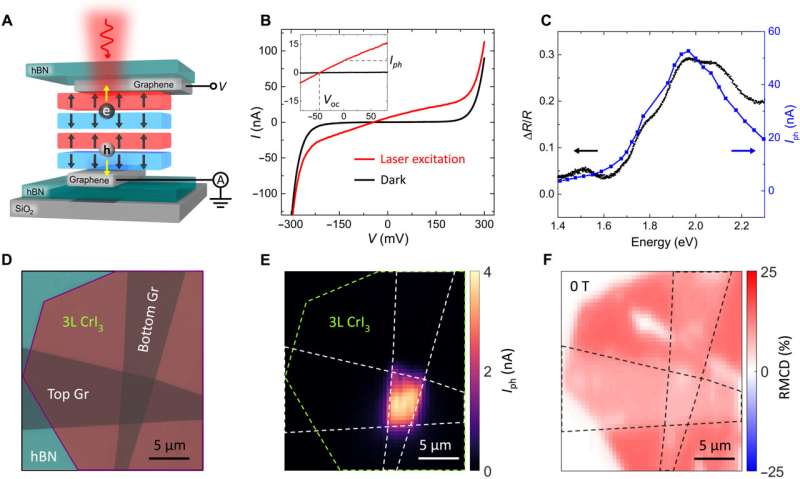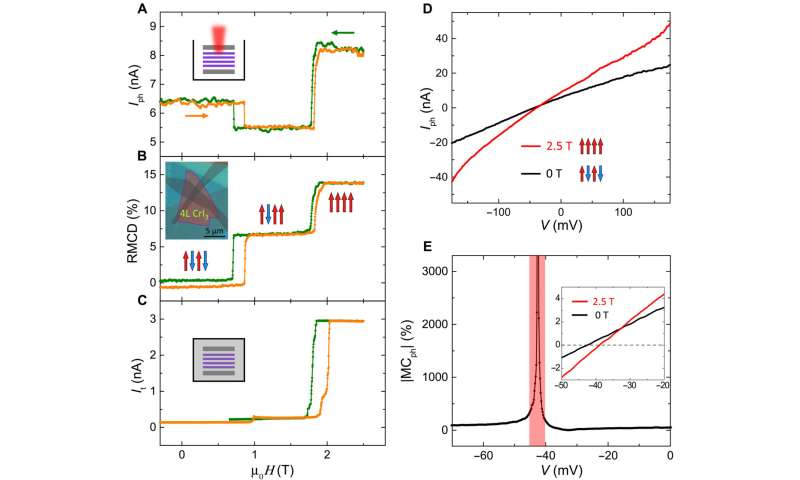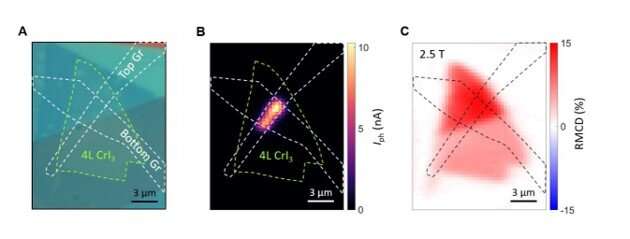September 14, 2021 feature
Spin photovoltaic effects in magnetic van der Waals heterostructures

In a new report now published on Science Advances, Tiancheng Song and a research team at the department of physics, University of Washington, U.S., and materials and nanoarchitectronics in Japan and China, detailed spin photovoltaic effects in van der Waals (vdW) heterostructures of two-dimensional (2D) magnetic chromium triiodide (CrI3) sandwiched by graphene contacts. The concept of van der Waals crystals and their heterostructures are of interest in materials science, applied physics and optoelectronics, to explore the optoelectronic properties within the two-dimensional (2D) limit. It is possible to integrate 2D magnets to realize 2D spin-optoelectronics with controlled spin degrees of freedom. The photocurrent of the CrI3 displayed a distinct dependence on light helicity, which Song et al. tuned by varying the magnetic states and photon energy. The research highlighted the potential to study the emergent phenomenon of photospintronics by engineering magnetic vdW heterostructures.
Spin photovoltaic effects
Spintronics aim to regulate the spin degree of freedom in electronic systems in order to facilitate new functions. The generation and control of spins can open new emerging opportunities in spin electronics to explore new spin photovoltaic effects and spin photocurrents. The spin photovoltaic effects can be realized using different mechanisms in various heterostructures, among which two-dimensional materials such as transition metal dichalcogenides are a promising system for spin-optoelectronics. The discovery of 2D van der Waals magnets have provided scientists a new platform to study spin-photovoltaic effects based on atomically thin materials with intrinsic magnetic order. Of these, chromium triiodide is of interest due to its layered antiferromagnetism (AFM), where the spin configurations can be regulated by a surrounding magnetic field. The field can switch the sample between the AFM ground states and fully spin-polarized states via a series of flip-transitions. The setup provides an ideal platform to highlight the spin-optoelectronic effects at the atomically thin limit.
![Helicity dependence of photocurrent in trilayer CrI3. (A) Photocurrent as a function of quarter-wave plate angle for ↑↑↑ state (2 T, red dots) and ↓↓↓ state (−2 T, black dots) measured from the trilayer CrI3 junction device (D1) with an optical power of 10 μW. Vertical arrows represent linearly polarized light. (B) The change in photocurrent [ΔIph [σ+ − σ−] = Iph(σ+) − Iph(σ−)] as a function of μ0H measured from the same device with an optical power of 10 μW. The degree of helicity ΔIph [σ+ − σ−]/(Iph(σ+) + Iph(σ−) given on right axis. Insets show the corresponding magnetic states and schematic of the device with circularly polarized light excitation. (C) RMCD as a function of μ0H for the same device. Insets show the corresponding magnetic states and the optical microscopy image of the device (D1). Scale bar, 15 μm. Credit: Science Advances, 10.1126/sciadv.abg8094 Spin photovoltaic effects in magnetic van der Waals heterostructures](https://scx1.b-cdn.net/csz/news/800a/2021/spin-photovoltaic-effe-2.jpg)
The researchers developed a vertical heterostructure to study the photocurrent response of CrI3 and to allow for efficient photodetection. The heterostructure contained an atomically thin CrI3 flake sandwiched by two graphene sheets as bias electrodes encapsulated by thin hexagonal boron nitride to prevent degradation. Using photocurrent microscopy, Song et al. further investigated the spatial distribution of the photocurrent and used reflective magnetic circular dichroism to map the trilayer CrI3 flake, where the photocurrent response showed a strong dependence on magnetic order. The team assigned the low and high photocurrent plateaus to the antiferromagnetism ground states and to the fully spin-polarized states. Comparatively, the intermediate magnetic states resulted in a lower photocurrent. The optical excitation generated photoexcited carriers in the conduction bands where asymmetric extraction by the top and bottom graphene electrodes resulted in the measured photocurrent. The spin-optoelectronic device presented here provided a novel photo-magnetocurrent effect compared to giant magnetoresistance and tunnel magnetoresistance devices. The resulting giant and tunable photo-magnetocurrent was useful for optically driven magnetic sensing and data storage devices.
-

Dependence of photocurrent on magnetic order of four-layer CrI3. (A) Photocurrent as a function of external magnetic field (μ0H) measured from the four-layer (4L) CrI3 junction device (D2) with an optical power of 1 μW. Green (orange) curve corresponds to decreasing (increasing) magnetic field. (B) RMCD as a function of μ0H for the same device. Insets show the corresponding magnetic states and the optical microscopy image of the device (D2). (C) Tunneling current (It) as a function of μ0H measured from the same device at 80-mV bias under dark condition. Insets are schematics of the device with laser excitation and under dark condition. (D) Iph-V curves for the four-layer CrI3 in the AFM ground state (↑↓↑↓, 0 T, black curve) and the fully spin-polarized state (↑↑↑↑, 2.5 T, red curve). (E) Magnitude of the photo-magnetocurrent ratio as a function of bias extracted from the Iph-V curves in (D). The red shading denotes the bias range where |MCph| tends to infinity. Inset is a zoomed-in view of the Iph-V curves in (D). Credit: Science Advances, 10.1126/sciadv.abg8094 -

Photocurrent mapping in four-layer CrI3. (A) Optical microscopy image of the four-layer CrI3 junction device (D2) (scale bar, 3 µm). (B) and (C) Spatial maps of photocurrent and RMCD signal measured from the same device at 2.5 T with an optical power of 1 µW (scale bar, 3 µm). Credit: Science Advances, 10.1126/sciadv.abg8094
Dependence of the photocurrent on light helicity and other effects
Song et al. showed the dependence of the photocurrent on light helicity using a trilayer CrI3 device with 1.96 eV of excitation. The resulting unique spin photovoltaic effect originated from the helicity dependence of charge-transfer excitons in CrI3 coupled to the underlying magnetic order. The helicity-dependence absorption of the device revealed the optical selection rules of the charge-transfer transitions between the spin-polarized valence and conduction bands to form the resulting velocity-dependent spin photovoltaic effect. Further observations also confirmed the underlying magnetic order to be the origin of the helicity dependence of the charge transfer excitons.
![Interplay between magnetic order and photon helicity in absorption and photocurrent of 3L CrI3. (A) Helicity-dependent ΔR/R spectra for all four magnetic states of 3L CrI3 at selected magnetic fields. Red (blue) dots correspond to σ+ (σ−) photon helicity. Insets show the corresponding magnetic states and the optical microscopy image of a trilayer CrI3 on sapphire. (B) Photocurrent as a function of quarter-wave plate angle for ↑↑↑ state (2 T, red dots) and ↓↓↓ state (−2 T, black dots) measured with three selected photon energies indicated by the dashed lines in (A). (C) ΔR/R helicity difference [(ΔR/R(σ+) − ΔR/R(σ−), curve] and the overlaid change in photocurrent [ΔIph [σ+ − σ−] = Iph(σ+) − Iph(σ−), squares] as a function of photon energy for ↑↑↑ state (2 T, red) and ↓↓↓ state (−2 T, black). Credit: Science Advances, 10.1126/sciadv.abg8094 Spin photovoltaic effects in magnetic van der Waals heterostructures](https://scx1.b-cdn.net/csz/news/800a/2021/spin-photovoltaic-effe-3.jpg)
Outlook
In this way, Tiancheng Song et al. studied the spin photovoltaic effects in atomically thin CrI3 van der Waals heterostructures. The photocurrents showed distinct responses to the spin configurations in CrI3 alongside a giant photo-magnetocurrent effect. The combined helicity-dependent photocurrent and circular polarization-resolved absorption measurements revealed the interplay between the spin photocurrent and the underlying excitons, as well as contributions of the magnetic order, photon energy and helicity. The 2D photovoltaic device developed here used the intrinsic magnetic order in few layer CrI3 as a proof-of-concept. The resulting atomically thin CrI3 formed an archetypal 2D magnet to study the photocurrent generated in a vertical junction device. The device can be adapted with alternate 2D magnets for potential applications in magnetic sensing and data storage. The underlying dynamics of magnetic order-coupled charge-transfer exciton states could generate a photocurrent to probe the magnetic order in CrI3 and show distinct responses to photon energy and helicity. The results highlight applications of the photocurrent as a new method to probe magnetic order, charge-transfer exciton states and magnetoexciton-photon coupling. The approach can be used to study other 2D magnetic systems including the dynamics of zig-zag antiferromagnetic order-coupled excitons and charge transfer processes at graphene interfaces.
More information: Song T. et al, Spin photovoltaic effect in magnetic van der Waals heterostructures, Science Advances (2021). DOI: 10.1126/sciadv.abg8094
Xiangnan Sun et al, A molecular spin-photovoltaic device, Science (2017). DOI: 10.1126/science.aan5348
Hongtao Yuan et al, Generation and electric control of spin–valley-coupled circular photogalvanic current in WSe2, Nature Nanotechnology (2014). DOI: 10.1038/nnano.2014.183
Journal information: Science , Science Advances , Nature Nanotechnology
© 2021 Science X Network


















